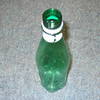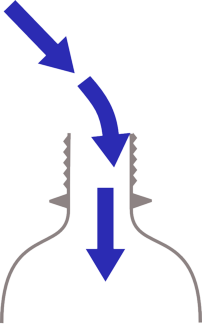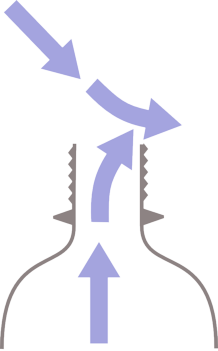Ingredients
 | A bottle, or if you have got them a selection. |  | A jug of water |
Instructions
Blow across the top of a bottle until you make a note, remember this sound.
Add some water
Blow across the bottle again. Is the sound the same?
Try different bottles, see what effect this has.
Result
You should find that the pitch of the note gets higher as you add more water.
If you try other bottles you should find that the large ones give a lower note than the small ones.
If you are musical and have you may be able to play a tune.
Explanation
When you blow on the edge of the bottle you are making a jet of air, if you hold your fingers nearby you can feel it. If you are making a noise this jet of air could either be deflected into the bottle or over the top of it, and it only takes a small force to change between these two paths.
If the air starts off going into the bottle, there is nowhere for it to escape so the pressure builds up, at some point the pressure builds up so much that the jet is pushed out of the bottle. Now the fast moving air sucks air out of the bottle until the pressure is low enough to suck the jet back in. You have made a vibration.
 |  |
| The air stream is sucked into the bottle, which pushes extra air into the bottle | Eventually the pressure inside the bottle gets high enough to push the jet outside again. Now the fast moving air of the jet sucks air out of bottle, reducing the pressure inside. |
Why does adding water make the pitch change?
Pitch is just a measure of how fast the vibration is that reaches your ear, rapid vibrations mean high pitches. In a large bottle there is a lot of space so it takes more air flowing in to build up enough pressure to push the jet out again. Getting more air into the bottle takes a relatively long time so the air vibrates slowly (at maybe 100 vibrations a second).
If you add water or use a smaller bottle there is less space available so it takes less time for the pressure to build up. This means the vibration happens more quickly and so produces a higher pitch.
 |  |
| An empty bottle has a large volume which means that the air behaves like a weak spring, because a lot of air has to move in to change the pressure much. | A half full bottle of water has less space for air inside, so it behaves as a stiffer spring, so it will vibrate faster. |
This is the principle that a flute works on, but instead of adding water you change the effective length of the tube by opening and closing holes.
- Previous Harmonic Knives
- Next Squashing Bottles










Comments
when you blew across the
when you blew across the bottle what was vibrating, the water, baton, air above the water, or the bottle
the air
the air
wait can u use plastic
wait can u use plastic bottles for that
yes you can use plastic
yes you can use plastic bottles for that
is the frequency more
is the frequency more connected to the volume of a vessel compared to Hertz vibration per second. If you half the volume do you increase the pitch by an octave for example .This works for string instrument by halving the length of the string so.... I am interested in natural tuning compared to tempered. The do re me that I hum is detuned about a tone and a bit ,wich fa or f2 vibrates with my heart when I put my hand on my chest .I believe this heart frequency really can heal but is different to the 528 hz promoted on the internet. I have been pronouncing this frequency with the vowel u onto my aching thumb and it has stopped aching through experimenting ive found the vowel u penetrates deep into my muscle and bone with my lips nearly touching or even touching the skin surface . I think the do re me vibrate different parts of your body and vowels help too
what's another similar method
what's another similar method to this where you can produce sound/pitch?
how can you change how loud
how can you change how loud the sound is?
You can blow harder!
You can blow harder!
Why do you have to be so
Why do you have to be so precise in blowing across the opening of the bottle? Why does the tone become less airy when you get the right angle?
Why is the note produced by
Why is the note produced by striking the bottle different than when you blow across the mouth of it?
Hello Dan.
Hello Dan.
The reason is that, when you hit the bottle, you are making the glass or plastic resonate (vibrate); the mass and shape of the glass/plastic, and the contents of the bottle, will affect how fast the material can vibrate and how quickly the vibrations die away (damp), both of which affect the pitch of the sounds transmitted back into the air as vibrations you can hear.
When you blow across the top of the bottle you are setting up a wave inside the bottle, the wavelength of which is determined by the height of the space between the bottle neck and the fluid level or bottom of the bottle. The bigger the distance the longer the fundamental wavelength that can "fit" into that space and hence the lower the note. So the sounds (of blowing across the neck versus hitting the sides) arise through two totally different and independent mechanisms and, hence, you would not expect them to be the same.
Add a comment